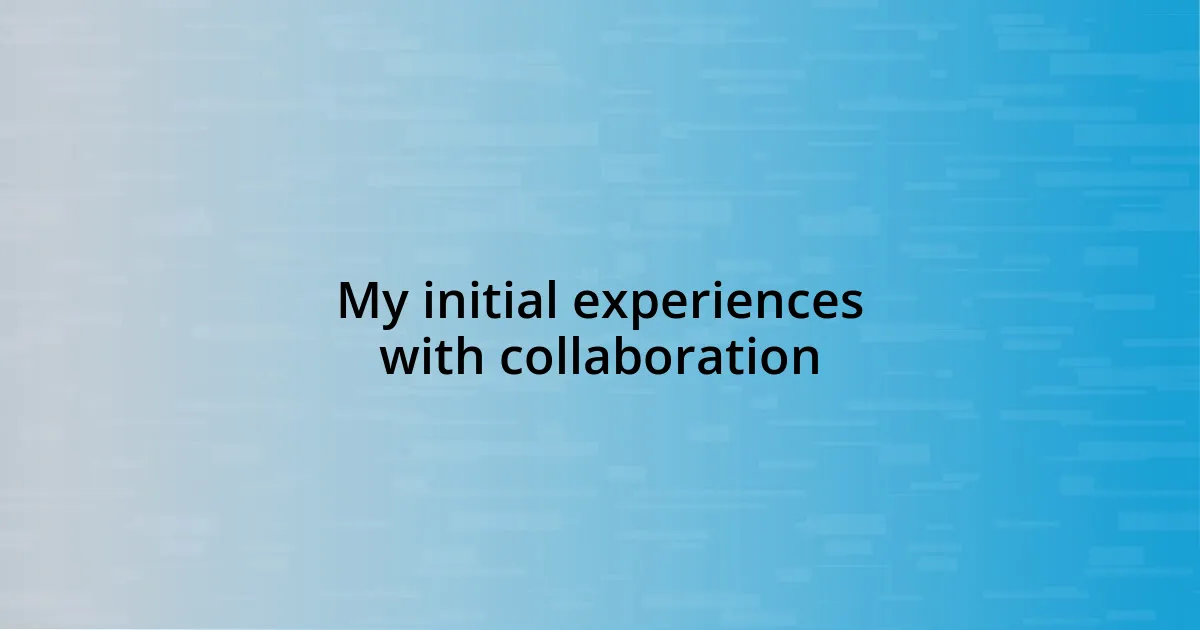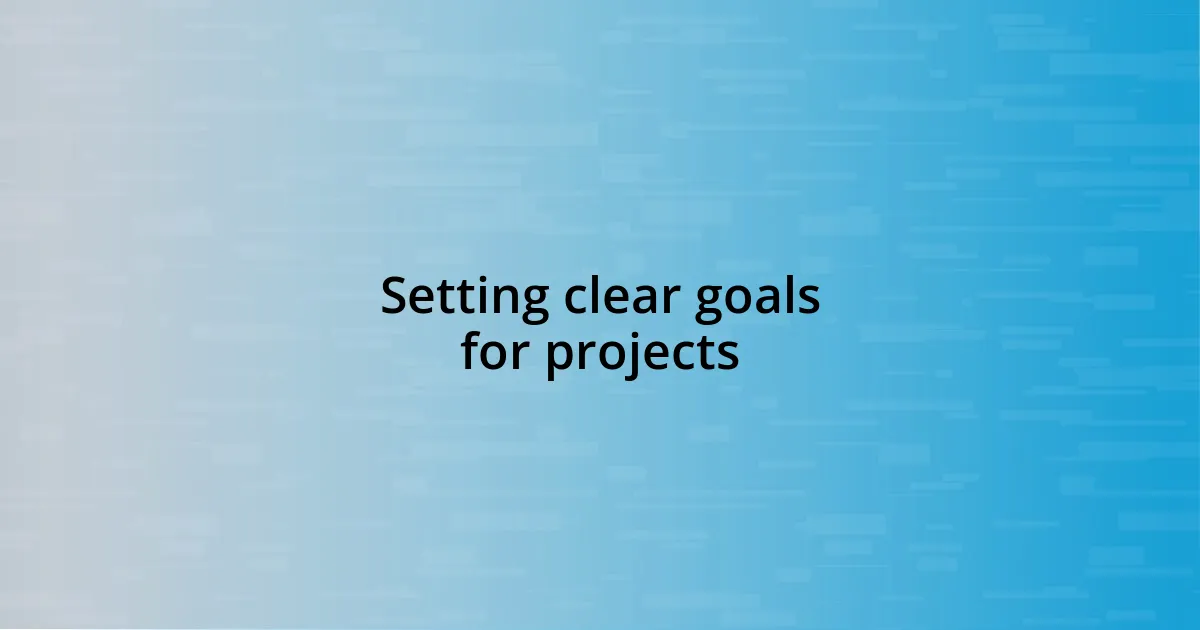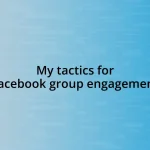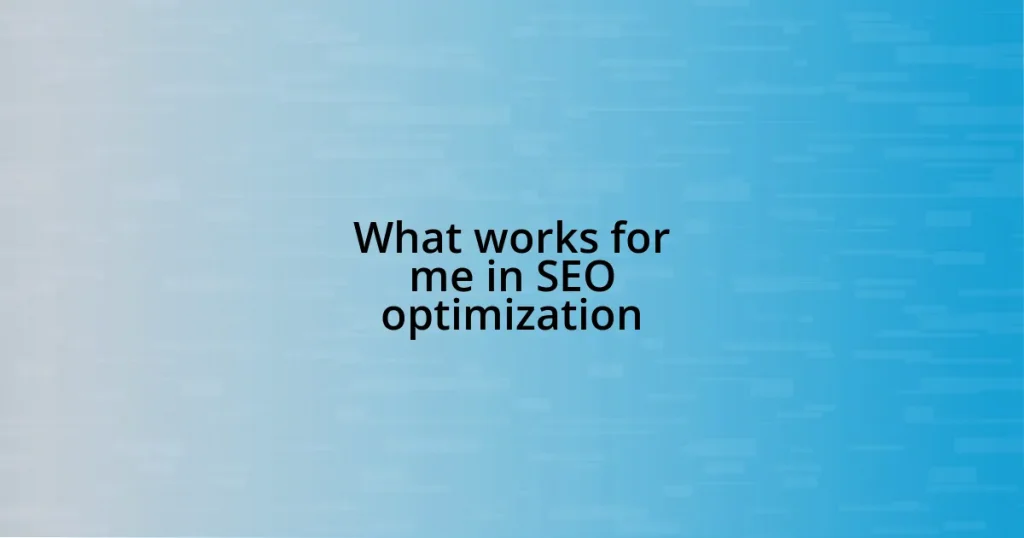Key takeaways:
- Collaboration opens up new creative possibilities and allows for blending unique strengths and perspectives.
- Effective communication, including regular check-ins and active listening, is crucial for building trust and resolving conflicts.
- Setting clear goals and timelines provides direction and accountability, while flexibility allows for creative evolution.
- Embracing vulnerability fosters deeper connections among collaborators and enhances the overall creative process.

My initial experiences with collaboration
I remember my first collaboration vividly. It was with a talented musician who had a completely different style than mine. I was nervous about how our artistic visions would mesh, but that project opened my eyes to the beauty of blending perspectives. How could something so different lead to such harmony?
One moment that stands out was during our brainstorming session. I felt a rush of excitement as we bounced ideas off each other, the energy in the room palpable. The best part? Realizing that our unique strengths complemented each other. Ever had that moment when you realize you’re creating something far better together than you ever could alone? That experience has stuck with me, echoing in my collaborations since.
Reflecting back, I see that initial foray into collaboration was as much about building trust as it was about creating art. There were moments of frustration, of wondering if we were on the right track. Yet, each hurdle taught me something valuable about communication and compromise, which are just as essential as creativity in any artistic endeavor. How often do we overlook the importance of those essential skills in our quest to create?

Finding the right collaborators
Finding the right collaborators can be a transformative aspect of any creative journey. It’s often a process of trial and error, where you discover not just who complements your style, but who shares your vision and values. I vividly recall a time when I was drawn to a fellow artist because of our mutual love for storytelling. What I didn’t expect was how our different mediums—my painting and her animation—could tell a more profound narrative together. That experience taught me that sometimes, the most unexpected partnerships yield the most beautiful results.
When seeking out collaborators, I recommend considering a few key points:
- Shared Values: Make sure your artistic visions align. It’s critical for sustaining a collaborative spirit.
- Complementary Skills: Look for someone whose talents fill gaps in your own. This could mean different styles or techniques.
- Communication Style: Find collaborators with whom you can communicate openly and honestly.
- Flexibility: Partner with artists willing to adapt and grow throughout the collaboration.
- Passion Alignment: Choose collaborators who share a similar level of commitment to the project.
These aspects can turn a simple collaboration into a dynamic creation experience, where each party feels heard and valued.

Setting clear goals for projects
Setting clear goals is the foundation of any successful collaboration. When I embarked on a recent project, my collaborator and I took the time to articulate our individual visions and expectations. It was a turning point for us; those conversations not only defined the project’s direction but also ensured we were both on the same page. I remember how sharing these goals felt like drawing a map together, guiding us through the creative process without losing our way.
One memorable instance was when we established a timeline for our project. Initially, I thought it was unnecessary, but as we reviewed our workload and personal commitments, it became clear this structure was essential. This clarity not only kept us accountable but also allowed for flexibility in our creative exploration. Have you ever been in a situation where a timeline saved the project from chaos? I realized then that setting these goals makes both the journey and the destination much more enjoyable.
Another critical aspect of goal-setting is being open to adjustments. In my experience, the initial goals might evolve as we progress. I once collaborated with an artist whose unique ideas shifted our focus significantly. Embracing this change led us to create something unexpectedly beautiful. It reminded me that while clarity is important, adaptability is equally valuable. After all, isn’t the creative process about discovering new paths?
| Aspect | Importance |
|---|---|
| Clear Goals | Sets a definitive direction for the collaboration |
| Defined Timelines | Ensures accountability and structure |
| Flexibility | Allows for evolving ideas and creativity |

Communicating effectively during partnerships
When collaborating with other artists, effective communication is essential. I remember a partnership where we set aside time for regular check-ins. It wasn’t just about sharing progress; it was about ensuring we understood each other’s feelings and challenges. Have you ever navigated a project where a simple check-in made all the difference? For me, it fostered a sense of trust and a deeper connection to our work. It kind of felt like syncing our creative rhythms, allowing us to flow together.
It’s also crucial to practice active listening during these conversations. There was a point in a past collaboration when my partner proposed an idea that initially seemed out of left field. Instead of dismissing it, I took a moment to listen and ask questions. Can you imagine how different the outcome would have been if I hadn’t? That idea turned into a pivotal element of our project. Engaging with each other’s thoughts and feelings helps build a partnership that feels collaborative in every essence.
Lastly, being transparent about challenges is vital. I once faced a creative block mid-project but hesitated to share it, fearing it would burden my collaborator. When I finally opened up, I was surprised at the relief I felt. It not only fostered understanding but encouraged my partner to share her frustrations too. This vulnerability strengthened our bond and shifted our direction in a fruitful way. Trust me, opening that line of communication is worth it; it can turn potential setbacks into opportunities for growth.

Navigating conflicts and challenges
Navigating conflicts is undoubtedly one of the more challenging aspects of collaborating with other artists. I remember a time when my vision clashed with my partner’s, leading to heated discussions that felt more personal than productive. It was a moment that pushed my emotional buttons, but I learned that taking a step back made all the difference. Do you think passion sometimes clouds our judgment in collaborations? I realized that focusing on the project rather than the disagreements helped us find common ground, transforming conflict into a path for deeper understanding.
On another occasion, we faced a logistical challenge that threatened to derail our creative flow. With deadlines approaching, I felt the pressure mounting, and I could sense my frustration rising. Instead of letting it bubble over, I proposed a brainstorming session to collectively address the issue. What if we turned our frustration into motivation? That shift in perspective not only alleviated tension but also sparked some brilliant ideas we hadn’t considered before. It reinforced my belief that sometimes, the best solutions lie in collaboration itself.
Lastly, it’s essential to recognize that challenges aren’t always negative—they can be incredible learning opportunities. During a past project, we hit a creative block that left us floundering for days. Initially, I felt disheartened, wondering if we should just scrap everything. But when my partner suggested taking a break to recharge, I felt a surge of hope. Have you ever found inspiration in rest rather than struggle? That time away reignited our creativity, enabling us to approach the project with fresh eyes and renewed enthusiasm. I learned that navigating challenges together can strengthen the bond between collaborators, turning trials into triumphs.

Showcasing our collaborative work
When it came to showcasing our collaborative work, one of my most memorable moments was a group exhibition we organized together. We each contributed pieces that reflected our individual styles while intertwining our themes. I can still recall the excitement of seeing our artworks hanging side by side, each telling a different part of the same story. Have you ever experienced that thrill when a group effort pays off? It felt like we were not just sharing our talents, but celebrating the synergy we had created.
We also explored digital platforms to reach wider audiences. During one initiative, we hosted an online gallery, featuring short videos where we discussed our creative processes. This approach not only highlighted our collaborative pieces but also allowed us to share insights into our journeys as artists. I was amazed by the feedback we received. People appreciated our candidness and expressed how it inspired their own artistic paths. Isn’t it incredible how technology can bring us closer and amplify our voices?
Another memorable way we showcased our work was through live performances. There was one event where we combined visual art with spoken word, creating a dynamic experience for the audience. I was nervous at first—performing always brings a different kind of vulnerability—but watching our art come to life was exhilarating. Each piece resonated differently with the viewers, and I could see the spark of inspiration igniting in many of them. Isn’t that why we create? To provoke thought and inspire others?

Lessons learned from my journey
One key lesson I’ve learned on my journey is the importance of open communication. There was a time when I assumed my collaborators understood my vision without me having to articulate it explicitly. This assumption backfired during a project where our styles unexpectedly clashed. I remember feeling frustrated and confused about how we could move forward. But once we sat down and openly discussed our individual perspectives, the project transformed. Have you ever felt that relief when misunderstandings are cleared up? It made me realize that voicing thoughts and feelings early on can prevent unnecessary tension down the line.
Another vital takeaway has been the power of embracing vulnerability. I used to shy away from sharing my insecurities about my work, thinking it would weaken my standing. However, I found that opening up about my artistic fears fostered a deeper connection with my collaborators. I vividly recall a moment when I shared my doubts about a piece we were working on together, and instead of criticism, I received support and encouragement. Isn’t it remarkable how vulnerability can turn into a bridge rather than a barrier? This experience taught me that authenticity not only enriches the creative process but also strengthens relationships.
Lastly, I’ve come to appreciate the beauty of flexibility in collaboration. There was a project where I was adamant about adhering to a specific plan, clinging to my original vision. But when an unexpected opportunity arose to explore a new direction, I hesitated at first. I remember the anxious chatter in my mind, wondering if I should just stick to what I knew. Ultimately, I decided to take the plunge with my partners, and it led us to a breakthrough that exceeded our expectations. Have you ever experienced that exhilarating rush of creativity when you allow spontaneity to guide the way? This lesson taught me that sometimes, letting go of control can lead to the most rewarding outcomes.















